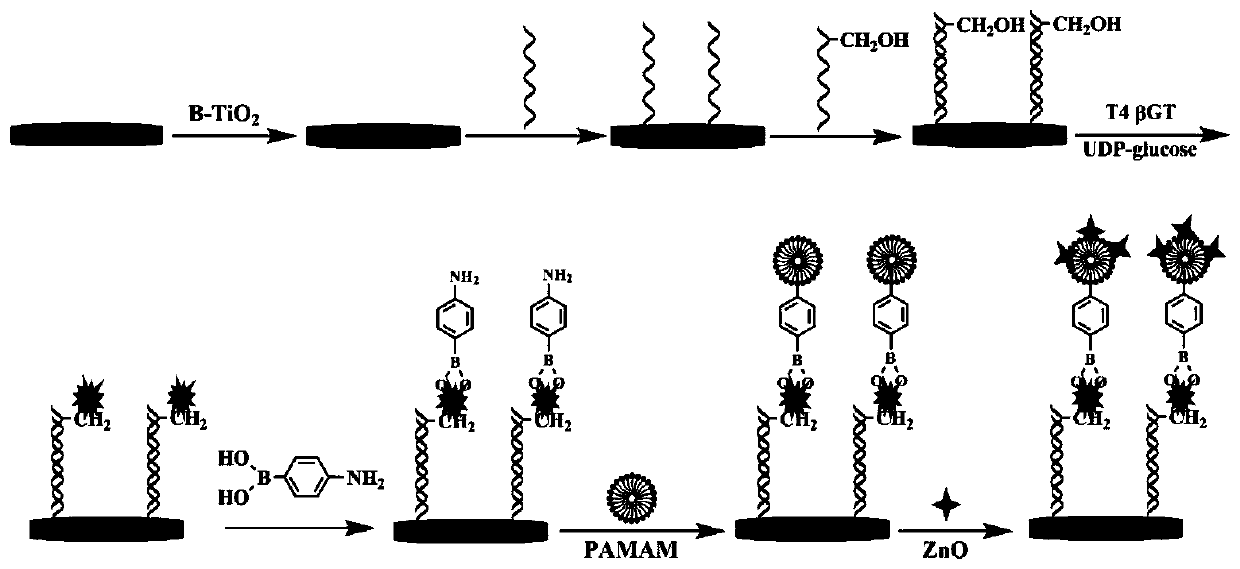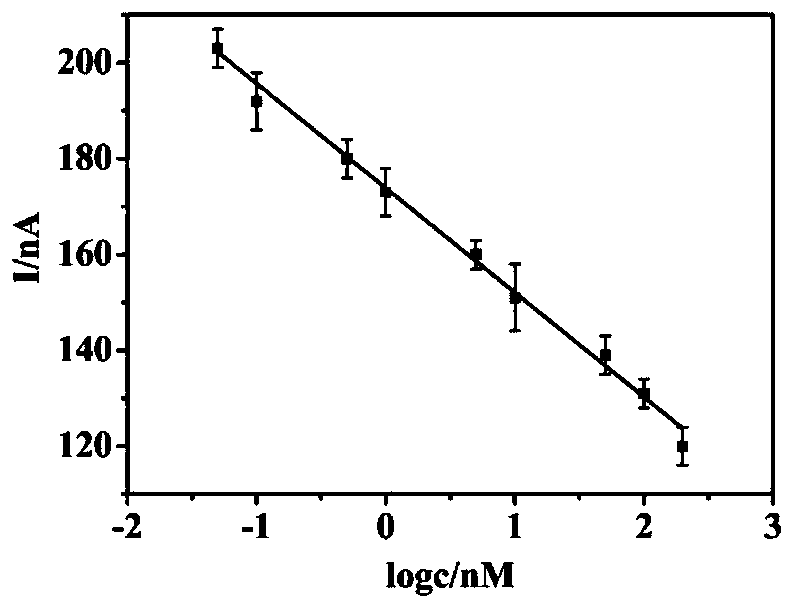Photoelectric chemical analysis method for detection of 5-hydroxymethylcytosine based on black titanium dioxide
A photoelectrochemical, black technology, applied in the field of detection of 5-hydroxymethylcytosine, can solve the problems of insufficient attention, complicated operation, separation of the two, etc., to improve the detection sensitivity, the detection method is simple, and the operation is easy. Effect
- Summary
- Abstract
- Description
- Claims
- Application Information
AI Technical Summary
Problems solved by technology
Method used
Image
Examples
preparation example Construction
[0080] (2) Black TiO 2 Preparation: Weigh 0.5-2g white TiO 2 , 0.5-2g of sodium borohydride was ground and mixed in a mortar. The mixture is put into a porcelain boat, and calcined at 200-400° C. for 0.5-2 hours under a nitrogen atmosphere. The obtained black solid was washed three times with deionized water and absolute ethanol respectively, and dried under vacuum at 60° C. for later use.
[0081] (3) Preparation of amino-modified zinc oxide: Weigh 0.1-1 g of zinc acetate and add it to 50 mL of absolute ethanol, and stir evenly. Then, 10-30 mL of 0.5M NaOH solution was added with stirring. Then the above solution was transferred to a reaction kettle for 4-8 hours at 120-180°C. The product was washed three times with deionized water and absolute ethanol, and then 0.5-1.5 g of the above product was weighed and added to 100 mL of 0.5 M NaOH solution, stirred and refluxed at 60-90° C. for 15-25 h. The product was washed three times with water and added to a mixed solution of...
Embodiment 1
[0100] Example 1: Black TiO 2 preparation of
[0101] Weigh 1g white TiO 2 , 1g of sodium borohydride was ground and mixed in a mortar. The mixture was put into a porcelain boat and calcined at 250 °C for 1 h under nitrogen atmosphere. The obtained black solid was washed three times with deionized water and absolute ethanol respectively, and dried under vacuum at 60° C. for later use.
Embodiment 2
[0102] Embodiment 2: Preparation of amino-modified zinc oxide
[0103] Weigh 0.4g of zinc acetate and add it to 50mL of absolute ethanol, and stir evenly. Then, 25 mL of 0.5M NaOH solution was added with stirring. Then the above solution was transferred to a reaction kettle for 6 hours at 150°C. The product was washed three times with deionized water and absolute ethanol, and then 1 g of the above product was weighed and added to 100 mL of 0.5M NaOH solution, stirred at 70°C and refluxed for 20 h. After the product was washed three times with water, it was added to a mixed solution of ethanol and water (1:1). With stirring, 3 mL of APTES was added followed by reflux for 20 h. Finally, the product was washed three times with water and dried under vacuum at 60°C for further use.
PUM
| Property | Measurement | Unit |
|---|---|---|
| Concentration | aaaaa | aaaaa |
Abstract
Description
Claims
Application Information
 Login to View More
Login to View More - R&D
- Intellectual Property
- Life Sciences
- Materials
- Tech Scout
- Unparalleled Data Quality
- Higher Quality Content
- 60% Fewer Hallucinations
Browse by: Latest US Patents, China's latest patents, Technical Efficacy Thesaurus, Application Domain, Technology Topic, Popular Technical Reports.
© 2025 PatSnap. All rights reserved.Legal|Privacy policy|Modern Slavery Act Transparency Statement|Sitemap|About US| Contact US: help@patsnap.com



